A Plankhouse Past
Unearthing an ancient Native American village provides glimpses of early life on North America's west coast.
By Emily Sohn
Few places on Earth remain unexplored. Pick an area almost anywhere and you’ll probably find detailed maps—and even guidebook advice about what to do once you get there.
It wasn’t always so easy to get around. Just 200 years ago, explorers Meriwether Lewis and William Clark embarked on an epic expedition across the United States. President Thomas Jefferson hired the men to lead a team along the Missouri and Columbia Rivers to see if they could find a river passage all the way to the West Coast.
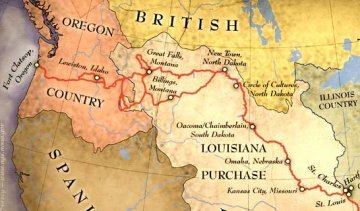 |
| NOAA |
Lewis and Clark’s 2-year journey, which started on May 14, 1804, took them from St. Louis to Oregon across the Rocky Mountains. Along the way, they discovered more than 300 new species of plants and animals, lots of unexpected geology and terrain, and nearly 50 Native American tribes.
Even though the explorers left behind detailed journals describing the people they met, much information about these tribes has been lost.
Malaria and other diseases killed large numbers of Native Americans (whose bodies weren’t prepared to fight the illnesses). Over the years, farms, new housing, and other developments buried their villages. Entire groups of people disappeared without any chance to tell their side of the story. The Chinookan people in the Northwest were one group that was hit particularly hard.
As the expedition’s 200-year-anniversary celebrations gear up, an archaeology-based project in Oregon seeks to focus attention on some of the people and places that Lewis and Clark came across on their journey.
At the Ridgefield National Wildlife Refuge near Portland, archaeologists and volunteers have spent more than 2 years building a traditional Chinookan building called a plankhouse. The building opened to the public this March as a living-history museum.
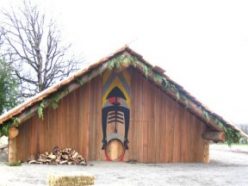 |
|
The completed plankhouse at the Ridgefield National Wildlife Refuge.
|
| Ridgefield National Wildlife Refuge, U.S. Fish and Wildlife Service |
Now, anyone can visit the plankhouse to get a glimpse of what life was like in the Northwest before waves of adventurous migrants followed Lewis and Clark’s path from the East.
Massive project
The construction project developed out of a massive archaeological effort a few miles away. On the banks of the Columbia River, just 10 miles downstream from Portland, researchers discovered a wealth of remains from a large Chinookan village that Lewis and Clark had visited twice on their journey.
The town, called Cathlapotle, made quite an impression on the explorers when they passed through in November 1805 and March 1806. For one thing, it was big, with an estimated 900 people in the town itself, 19,000 in the immediate area, and some 200,000 people living along the river valley. The men also noted the large houses and a busy fur trade, and they were impressed.
Here’s an excerpt from Clark’s journal entry about the encounter:
I observed on the Chanel which passes on the Star’d Side of this Island a Short distance above its lower point is Situated a large village, the front of which occupies nearly 1/4 of a mile fronting the Chanel, and closely Connected, I counted 14 houses (Quathlapotle nation) in front here the river widens to about 1-1/2 miles. Seven canoes of Indians came out from this large village to view and trade with us, they appeared orderly and well disposed, they accompanied us a fiew miles and returned back.
Even though Lewis and Clark left behind detailed maps and descriptions of the village, it took archaeologists a long time to find the site. By the 1980s, the village lay buried under rolling hills and stands of oak. “There are probably 10 times as many trees here today,” says archaeologist Anan Raymond. He works for the U.S. Fish and Wildlife Service (USFWS).
Village life
When digging finally began in 1991, archaeologists from the USFWS and Portland State University were amazed by what they found.
“It was bigger than we all anticipated,” says lead archaeologist Ken Ames of Portland State. He and his coworkers unearthed more than 10,000 artifacts, including daggers, blades, beads, animal hides, acorns, hazelnuts, roots, lots of wapato (a potato-like food), pieces of copper, and bones from fish, such as smelt, and other animals.
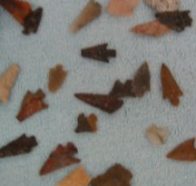 |
|
Arrowheads found at the Cathlapotle site.
|
| Emily Sohn |
The discovery turned out to be one of the richest and best-preserved Native American sites in North America. There was so much stuff, the archaeologists had to stop digging after 5 years, having excavated just three percent of the village.
By 1996, the researchers had identified the outlines of six plankhouses, and they excavated a large portion of two of them. It wasn’t easy to do. All of the wooden planks and beams have disintegrated long ago. The archaeologists had to dig long trenches, about 4 feet wide. Then, they looked for impressions in the dirt.
Using this method, the archaeologists were able to see stains where support beams and walls used to be. They could see the outlines of storage pits underneath the houses. And they found ash and burned items, evidence of hearths for cooking.
Based on the material they picked up, the researchers were able to piece together much of what Chinookan life was like 200 years ago. Plankhouses, it seems, were central to the native people’s culture.
Some of the buildings were as big as 180 feet long, 35 feet wide, and 18 feet tall. Between 20 and 100 people (or more) lived in a single house, Ames says, and families were grouped together. People slept, cooked, worked, worshiped, and socialized in the large wooden houses.
Mystery stuff
The piles and piles of artifacts have suggested a whole slew of new questions about the Chinookan people and their lives. “What were they doing with all this stuff?” Ames asks. “We don’t know yet.”
The Chinookan people don’t seem to fit into our usual categories of how societies work, Ames says. They weren’t roaming hunter-gatherers, but they also weren’t really farmers because they weren’t actually planting things. Some experts suspect that the Chinookan people helped plants grow better by simply clearing land or using other methods.
The native people may have also had some effect on the animals in the area. Elk bones discovered at Cathlapotle are bigger than any elk bones recorded anywhere else. Some scientists suspect that the Chinookan people created an environment that allowed elk to become enormous. Others argue that the elk may have just been a different subspecies.
As archaeologists continue to sift through the data for answers, volunteers for the plankhouse project have gained their own appreciation of the Chinookan people. Building a plankhouse, they learned, takes a lot of organization and hard work.
Plankhouse project
The modern version isn’t an exact replica of the traditional houses. Hundreds of years ago, it took 500 people or more to build the houses by hand. Today’s force included about 60 volunteers, and just a dozen or so showed up once a week to work.
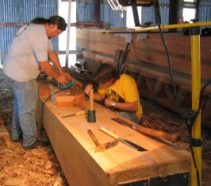 |
|
Tony Johnson (left) and Adam McIsaac carve a tall sculpture for the plankhouse.
|
| Emily Sohn |
By necessity, the volunteers used cranes, chainsaws, and other modern equipment to complete the project. And today’s laws required such features as emergency lighting and swinging doors for safety.
Still, the volunteers carved figures by hand into beams. They made mats, oars, and artwork for the building. Future workshops at the plankhouse will introduce visitors to these traditional skills.
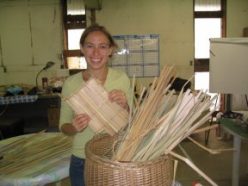 |
|
Emily attends a mat-making workshop.
|
| Courtesy of Emily Sohn. |
“This is a good opportunity for us to impress the average American with native technologies,” says tribe member Tony Johnson. “I’m still convinced some Americans think we scraped rocks and hit sticks together. But here we had 190-foot houses, full of beautiful art.” The project has already brought native and non-native volunteers together to learn about each other’s cultures.
Best of all, Raymond says, the spirit of the plankhouse will endure as long as the plankhouse remains standing, and that should be a long, long time. “The thing that’s great about it,” he says, “is that it’s not about Lewis and Clark. It’s going to transcend that. It’s going to last long after all the hoopla is over.”
Going Deeper:







